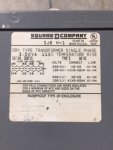Plant has 480/277 main service. Many dry types connected Delta-Wye to 208/120. All 3 phase.
There are two PLC panels, installed years apart. These serve HVAC system with many units on the roof.
Voltage from POCO is intentionally reduced 3% during their peak and some of the roof units drop out. EC points to 3kVA 1-1 transformer serving PLC panel.
This isolation transformer is connected 120-N and served by a 75kVA dry type, .
What we measured for voltage at the 1-1, source 118.7 - load 119.8.
Amps; source 7+ - load 2.5.
Temperature of 1-1 running 160F.
Problem at PLC only occurred when POCO reduces voltage at their substation, that is not very far away.
The PLC panel in another part of the plant does not have an isolation transformer and is powered by 120 from the same 75kVA that serves the other PLC panel with the 1-1.
I was on the main when voltage was reduced and POCO never went below 460. Math says around 115 at primary of the 1-1. This should not be a problem.
A similar 1-1 on a different application was tested today. it was running a little hotter with less load but the primary voltage was still lower than secondary.
We could not disconnect to do a TTR.
Why is 1-1 primary lower than 1-1 secondary?
Have engineering ideas changed where years ago an isolation transformer was thought necessary and now the need is not there?
Thanks.
There are two PLC panels, installed years apart. These serve HVAC system with many units on the roof.
Voltage from POCO is intentionally reduced 3% during their peak and some of the roof units drop out. EC points to 3kVA 1-1 transformer serving PLC panel.
This isolation transformer is connected 120-N and served by a 75kVA dry type, .
What we measured for voltage at the 1-1, source 118.7 - load 119.8.
Amps; source 7+ - load 2.5.
Temperature of 1-1 running 160F.
Problem at PLC only occurred when POCO reduces voltage at their substation, that is not very far away.
The PLC panel in another part of the plant does not have an isolation transformer and is powered by 120 from the same 75kVA that serves the other PLC panel with the 1-1.
I was on the main when voltage was reduced and POCO never went below 460. Math says around 115 at primary of the 1-1. This should not be a problem.
A similar 1-1 on a different application was tested today. it was running a little hotter with less load but the primary voltage was still lower than secondary.
We could not disconnect to do a TTR.
Why is 1-1 primary lower than 1-1 secondary?
Have engineering ideas changed where years ago an isolation transformer was thought necessary and now the need is not there?
Thanks.


